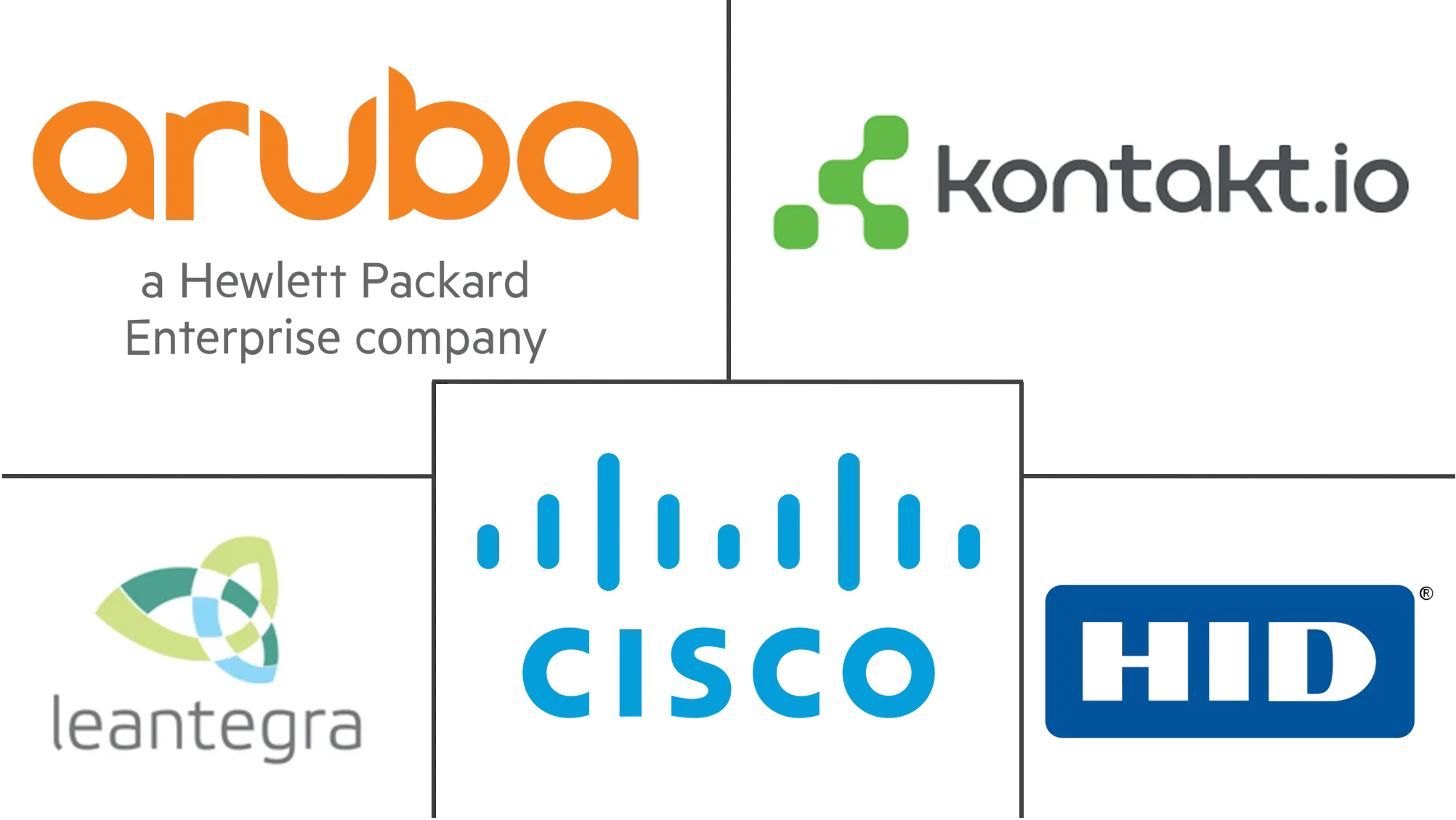Smart Beacon Market Size and Share
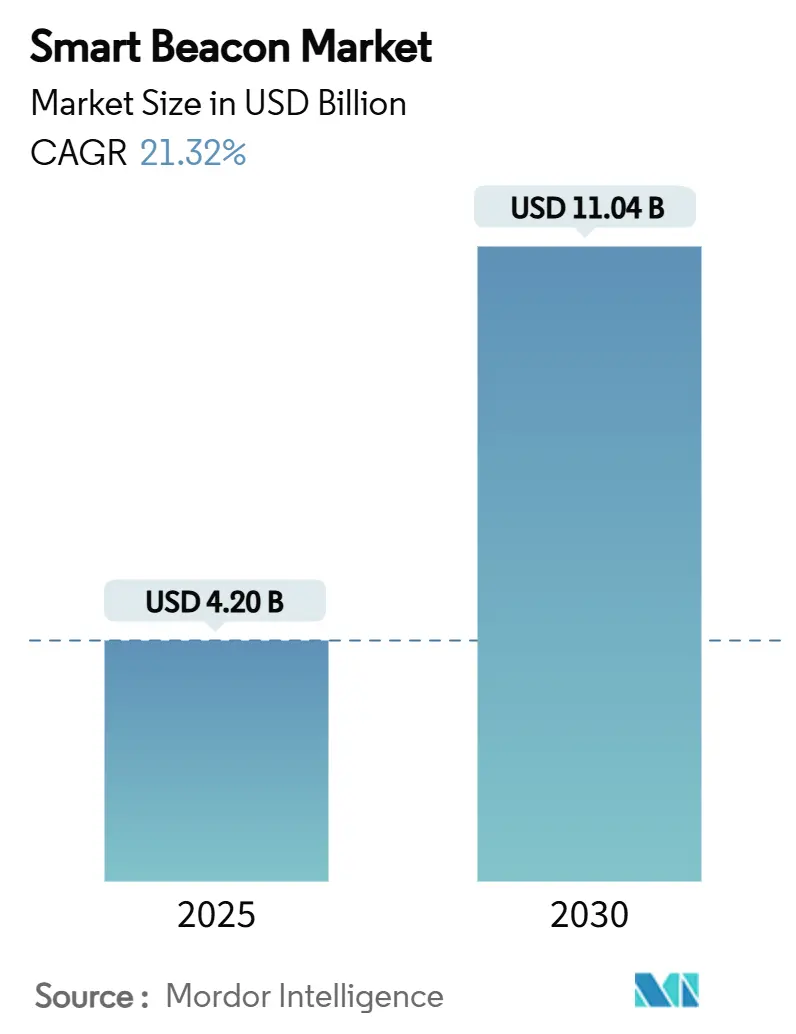
Smart Beacon Market Analysis by Mordor Intelligence
The smart beacon market reached USD 4.2 billion in 2025 and is forecast to advance to USD 11.04 billion by 2030, translating to a 21.32% CAGR over the period. Growth is propelled by enterprises moving from simple proximity notifications toward ambient IoT ecosystems that harvest energy from surrounding RF, light, and motion sources while interfacing with unified smart-building protocols. Retailers embrace real-time spatial analytics to lift conversion rates, healthcare providers deploy RTLS to locate critical assets and patients, and logistics operators embed beacons into supply-chain workflows to cut search time and shrinkage. Concurrently, energy-harvesting tags are lowering lifetime ownership costs, and tightening privacy mandates are reshaping solution design around explicit opt-in engagement. These converging factors position the smart beacon market as a foundational layer of next-generation indoor intelligence platforms. [1]GameStop Corp., “GameStop Enhances In-Store Experience with Beacon Technology,” gamestop.com
Key Report Takeaways
- By standard type, iBeacon led with a 61% revenue share in 2024, while Eddystone is projected to expand at a 28% CAGR through 2030.
- By connectivity, Bluetooth Low Energy held 82% of the smart beacon market share in 2024, whereas Wi-Fi 802.11mc is set to climb at a 29.5% CAGR to 2030.
- By end-user industry, Retail and Malls commanded 37% of the 2024 smart beacon market size; Healthcare Facilities represent the fastest-growing segment with a 25.4% CAGR outlook.
- By application, Proximity Marketing accounted for 42% of 2024 revenue, while Asset and Personnel Tracking is accelerating at a 27.3% CAGR through 2030.
- By geography, North America captured 33.5% of global revenue in 2024, yet Asia-Pacific is forecast to grow the quickest at 24.8% CAGR to 2030.
Global Smart Beacon Market Trends and Insights
Drivers Impact Analysis
| Driver | (~) % Impact on CAGR Forecast | Geographic Relevance | Impact Timeline |
|---|---|---|---|
| Growing demand for spatial analytics in retail foot-fall optimisation | 4.20% | Global, concentration in North America & EU | Medium term (2-4 years) |
| Surge in beacon-enabled supply-chain visibility | 5.80% | APAC core, spill-over to North America | Long term (≥ 4 years) |
| Energy-harvesting, battery-free beacons cut lifetime TCO | 3.10% | Global, early adoption in EU & Japan | Long term (≥ 4 years) |
| Integration with Matter & unified smart-building protocols | 4.70% | North America & EU, expanding to APAC | Medium term (2-4 years) |
| Source: Mordor Intelligence | |||
Growing Demand for Spatial Analytics in Retail Foot-Fall Optimisation
Retailers have progressed from static heat maps to dynamic orchestration engines that adapt promotions in real time as shoppers dwell near specific shelves. GameStop deployed beacons across 100 stores to surface game-specific content and combat showrooming, translating location cues into targeted upsell prompts. Macy’s Black Friday “Walk in and Win” campaign blended digital scratch-off games with in-store positioning, boosting app installs and capturing granular path-to-purchase data. Telstra Retail validated 95% foot-traffic counting accuracy by fusing edge AI with identity masking, satisfying privacy expectations while preserving insight quality. These examples show that differentiated spatial intelligence can raise conversion, manage staffing, and refine assortment decisions, sustaining investment even as overall retail traffic fluctuates. [2]Telstra Corp., “AI-Powered Retail Analytics Solution Delivers 95% Accuracy,” telstra.com
Surge in Beacon-Enabled Supply-Chain Visibility
Asset visibility has shifted from convenience to operational mandate. Sky Warehouse embeds beacons on cargo pallets to cut search time and prevent misplacement, improving dock-to-dock flow metrics. Beijing’s vehicle-road-cloud pilot uses 7,000 5G-A macro cells and dense beacon clusters to orchestrate autonomous freight within logistics parks, proving that centimetre-level indoor accuracy can extend outdoor V2X continuity. Link Labs logged a 30% reduction in equipment search time and 15% fewer duplicate purchases across multi-facility hospital systems after rolling out its beacon-based RTLS platform. Siemens Logistics integrates beacon data with baggage-handling software to balance conveyor load and save energy. These cases underline why supply-chain operators are emerging as a dominant demand pool within the smart beacon market. [3]Link Labs Inc., “Healthcare RTLS Reduces Equipment Search Time by 30%,” link-labs.com
Energy-Harvesting, Battery-Free Beacons Cut Lifetime TCO
Power maintenance once restricted multi-year deployments. Wiliot’s second-generation IoT Pixels harvest ambient RF to transmit temperature and location data without batteries, shifting the cost curve for item-level tracking. MIT researchers created magnetic-field harvesters powering sensors that monitor remote machinery, illustrating viable industrial use where battery swaps are infeasible. Atmosic demonstrates photovoltaic and thermal energy harvesting that can prolong tag life indefinitely. For operations managing tens of thousands of tags, eliminating routine battery replacement reduces labour overhead and e-waste, materially broadening the smart beacon market addressable base.
Integration with Matter and Unified Smart-Building Protocols
Interoperability barriers are dissolving as Matter and enhanced Bluetooth LE channel-sounding gain traction. Apple has embedded UWB across most devices since 2019, and adoption projections exceed 60% of active iPhones by 2030, paving the way for secure digital keys and fine-ranging navigation. Bluetooth SIG’s 2024 channel-sounding update delivers sub-meter accuracy over BLE while maintaining low power. South Korea’s 48 private 5G networks underline how dedicated spectrum can backhaul high-density beacon telemetry for AI analysis. EASA’s privacy-by-design guidelines for drone positioning systems reinforce the regulatory push toward secure, interoperable indoor-outdoor continuity. Unified protocols relieve vendor-lock concerns and simplify multi-standard deployments, accelerating enterprise decision cycles.
Restraints Impact Analysis
| Restraint | (~) % Impact on CAGR Forecast | Geographic Relevance | Impact Timeline |
|---|---|---|---|
| Scarcity of skilled BLE RF engineers for large-scale roll-outs | -2.80% | Global, acute in North America & EU | Short term (≤ 2 years) |
| Privacy-by-design mandates restrict passive data capture | -1.90% | EU primary, expanding global | Medium term (2-4 years) |
| 2.4 GHz spectrum congestion in dense IoT estates | -1.40% | Urban centers globally | Long term (≥ 4 years) |
| Slow OS-level support for background scanning post-iOS 15 | -2.10% | Global, iOS-dependent markets | Medium term (2-4 years) |
| Source: Mordor Intelligence | |||
Scarcity of Skilled BLE RF Engineers for Large-Scale Rollouts
The United States alone faces a projected 67,000 semiconductor-engineering shortfall by 2030, and BLE RF expertise is among the rarest subsets. McKinsey notes that only 43,500 of the 48,000 new technician roles needed by 2030 may be filled, creating a bottleneck that inflates project timelines and wages. A 2024 workforce survey found 53% of semiconductor employees contemplating resignation within six months, compounding churn. Beacon rollouts in hospitals or factories require precise antenna tuning, channel-interference mitigation, and power calibration that automated design tools cannot yet replicate. Vendors struggling to secure seasoned RF talent risk cost overruns and client dissatisfaction, limiting near-term uptake despite robust underlying demand.
Privacy-by-Design Mandates Restrict Passive Data Capture
Europe’s 2025 GDPR update tightens consent protocols, curbing passive presence detection that once powered granular foot-tall analytics. Apple and Google introduced unwanted-tracking alerts requiring explicit opt-in for background beacon discovery, reducing anonymous data volume. The EU Cyber Resilience Act layers cybersecurity standards onto device design, extending R and D cycles and raising compliance costs. Apple’s private Wi-Fi address rotation and stricter Bluetooth permission workflows started in iOS 18.2 shift data processing toward on-device models, forcing vendors to redesign analytics pipelines. These moves reorient the smart beacon market toward overt value exchange—such as loyalty perks—instead of silent observation, altering ROI calculus for some retail scenarios.
Segment Analysis
By Standard Type: Eddystone Chips Away at iBeacon Primacy
iBeacon accounted for 61% of 2024 revenue, reflecting Apple’s early push and embedded support within its mobile OS ecosystem. Eddystone, however, is growing at a 28% CAGR as enterprises favour Google’s web-centric Physical Web model that removes the friction of mandatory app downloads. The smart beacon market size for Eddystone deployments is forecast to expand sharply as building-management platforms embed native support and as Matter bridges multiple radio stacks. AltBeacon maintains a loyal base among industrial users seeking vendor-neutral frameworks.
A deeper look reveals platform strategy is the true differentiator. Apple’s consolidation of Ultra-Wideband and BLE in a single radio front end enables secure access control and spatial computing scenarios unavailable when iBeacon launched. Google counters by making broadcast URLs discoverable in Chrome and Android Quick Settings, empowering public-space operators to push context without cultivating native apps. This dual trajectory encourages enterprises to adopt multi-standard stacks, intensifying demand for gateway devices that translate among iBeacon, Eddystone, and AltBeacon payloads inside the broader smart beacon market.
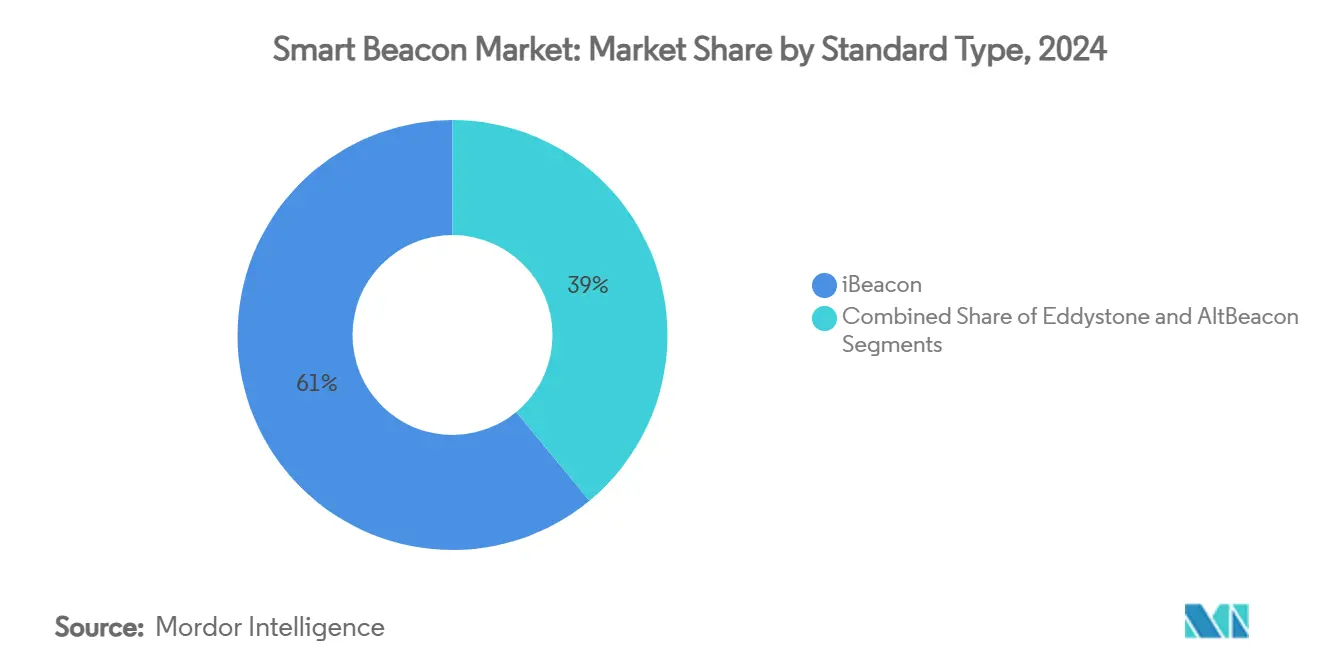
Note: Segment shares of all individual segments available upon report purchase
By Connectivity: Wi-Fi FTM Mounts a Precision Challenge
Bluetooth Low Energy retained 82% market share in 2024 thanks to unrivalled chipset availability and sub-milliwatt power draw that keeps battery-based tags alive for years. Yet Wi-Fi 802.11mc fine-time-measurement is rising at a 29.5% CAGR as hospitals, airports, and warehouses seek centimetres-grade accuracy without deploying additional radios; existing Wi-Fi access points only need firmware upgrades. The smart beacon market share for BLE will remain the largest through 2030, but its dominance will narrow as hybrid BLE + Wi-Fi tags proliferate.
Ultra-Wideband plays a specialist role where security and sub-10 cm accuracy justify higher bill-of-materials, such as infant-abduction prevention or automated guided vehicles. Meanwhile, Bluetooth SIG’s new channel-sounding extension promises sub-meter precision over standard BLE, blunting Wi-Fi’s accuracy advantage. Connectivity decisions now revolve around latency tolerance, battery life expectations, and capital budget rather than any single protocol’s technical merit, diversifying revenue streams within the smart beacon market.
By Application: Asset Tracking Surges Beyond Promotion
Proximity Marketing and Couponing still delivered 42% of 2024 revenue, proving that push notifications remain valuable when paired with loyalty wallets. Yet Asset and Personnel Tracking is growing at 27.3% CAGR, reflecting the operational priority placed on real-time visibility. Zebra Technologies disclosed USD 1.334 billion in Q4 2024 revenue, crediting enterprise mobility and beacon-enabled asset intelligence for its 32.2% top-line growth.
The pivot toward tracking aligns with rising labour costs and compliance mandates. Manufacturers embed beacons into work-in-progress trays to orchestrate just-in-time flows; airports track ground-support equipment to shrink turnaround times. Indoor navigation and occupancy sensing round out demand by linking space utilization with energy management. Together, these trends expand the smart beacon market size across both revenue and volume, diluting its reliance on consumer engagement budgets.
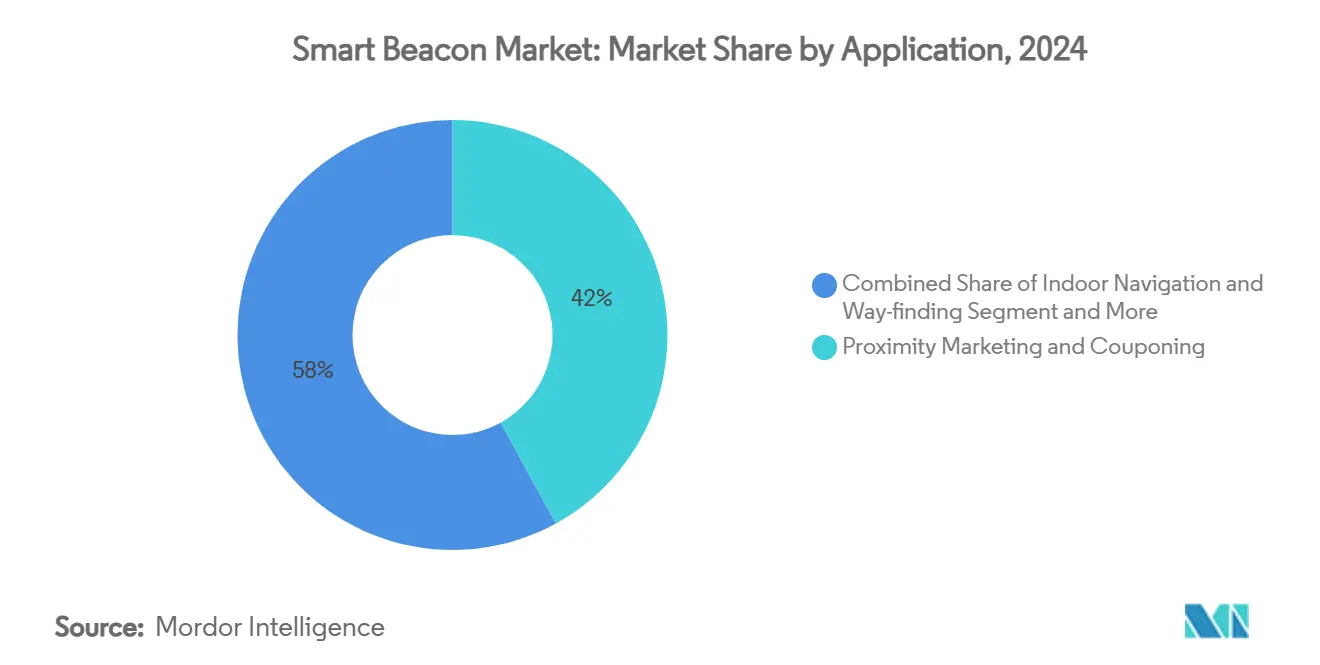
Note: Segment shares of all individual segments available upon report purchase
By End-User Industry: Healthcare Outpaces Retail Legacy
Retail and Malls held 37% of 2024 revenue as proximity-marketing programs matured and omnichannel strategies kept stores relevant. Healthcare Facilities, however, are expanding fastest at 25.4% CAGR because RTLS addresses staffing shortages, infection-control workflows, and regulatory reporting. In 2024, Link Labs quantified a 30% reduction in equipment search time for hospitals adopting beacon RTLS, while Kontakt.io secured USD 47.5 million to accelerate AI-based patient-flow optimization.
Unlike the discretionary nature of consumer promotion cycles, hospital directors integrate beacons into electronic health records and nurse-call systems, embedding them in core clinical operations. Capex decisions, therefore, lean on risk mitigation and patient-safety metrics rather than marketing ROI. This structural demand stabilizes growth, insulating the smart beacon industry from retail downturns and underscoring why healthcare investment has become a bellwether for long-term market health.
Geography Analysis
North America captured 33.5% of global revenue in 2024 on the back of early retail rollouts and stringent healthcare compliance that mandates asset location auditing. United States hospitals such as Stanford Health integrate beacons with nurse-call platforms to automate staff-response metrics, while Canadian smart-building retrofits in Toronto and Vancouver leverage beacons to synchronize HVAC and lighting for LEED certifications. Adoption remains steady, though privacy legislation and iOS background-scanning limits may temper growth relative to emerging regions.
Asia-Pacific posts the fastest 24.8% CAGR through 2030. China’s 500-plus smart-city pilots integrate 2.57 billion IoT endpoints that anchor dense beacon meshes for public transit, safety monitoring, and retail analytics. South Korea’s USD 4.6 billion Smart K-Cities initiative and 48 private 5G networks deliver low-latency backbones ideal for centimeter-grade positioning. Japan’s medical MaaS segment, valued at JPY 17.6 billion (USD 117 million) in 2025, exemplifies healthcare-focused demand. Combined, these factors place Asia-Pacific at the forefront of scaling the smart beacon market.
Europe advances on the strength of privacy-compliant smart-building investments. Germany pushes factory digitalization under Industrie 4.0, deploying beacons in intralogistics zones, while the United Kingdom retrofits historical infrastructure with Bluetooth-based visitor guidance tools that respect GDPR. The EU’s Cyber Resilience Act sets a harmonized security baseline that vendors must meet, raising entry thresholds but also building trust in mission-critical deployments. Collectively, these trajectories ensure balanced global contributions while confirming Asia-Pacific as the growth engine.
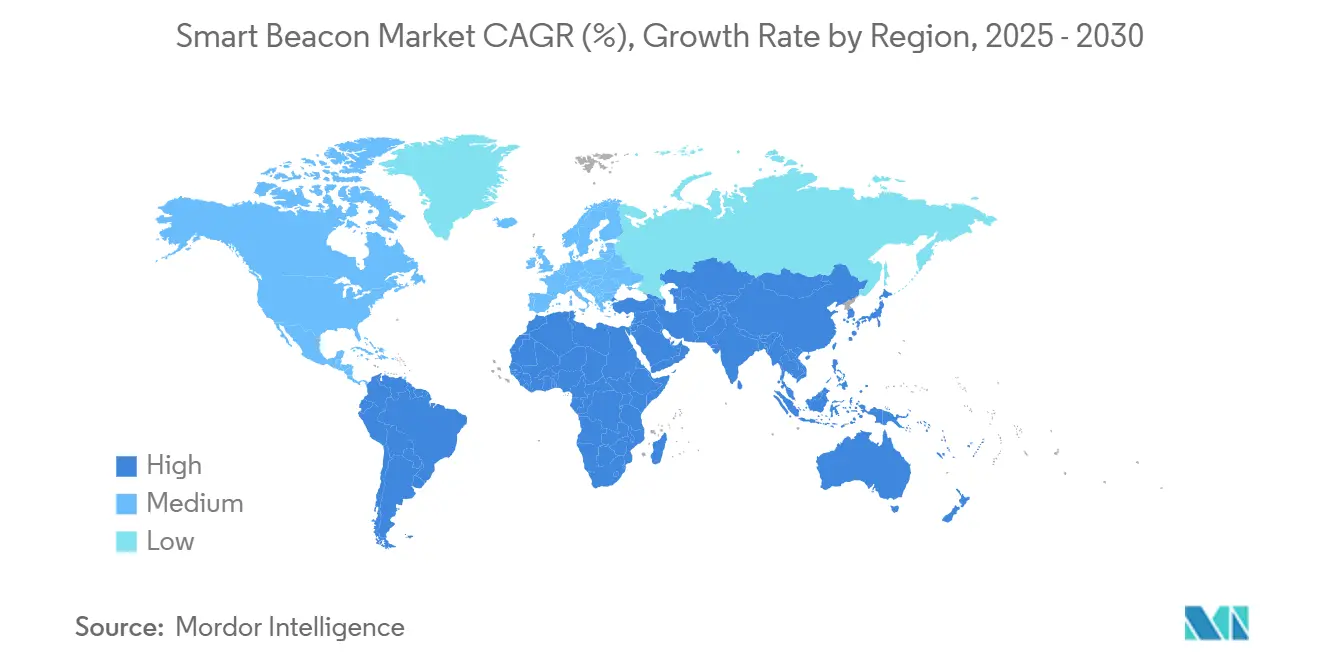
Competitive Landscape
The smart beacon market shows moderate concentration, with no vendor exceeding a 15% global share. Large enterprise-mobility providers bundle beacons inside broader edge-computing platforms, whereas specialists excel in healthcare or industrial niches. Zebra Technologies recorded 11.3% year-over-year revenue growth in Q1 2025 to USD 1.308 billion, aided by its acquisition of Photoneo for enhanced 3D vision that complements beacon-based location data. Kontakt.io employs 153 staff and generates an estimated USD 50.2 million annually, channelling fresh capital toward hospital AI workflows.
Strategic playbooks diverge. Platform integrators—Cisco, Apple, Google—leverage existing device or network footprints to embed beacon services with minimal marginal cost. Vertical specialists prioritize regulatory expertise, as seen in Kontakt.io’s HIPAA-aligned dashboards. Technology differentiators like Wiliot and Atmosic pursue energy harvesting to erase battery maintenance, an innovation that could compress total cost of ownership by double-digit percentages over multiyear horizons. Patent filings around RF energy and privacy-preserving analytics hint that future competitive edges will pivot on sustainability and compliance rather than broadcast range alone.
Mergers are likely as customers demand multi-standard, multi-protocol solutions. Semiconductor shortages and RF-engineering talent gaps create acquisition rationales for firms seeking to internalize scarce capabilities. Nonetheless, the pace of consolidation will remain measured; heterogeneous use cases and region-specific regulations preserve room for specialized entrants, keeping the smart beacon industry dynamic.
Smart Beacon Industry Leaders
-
Hewlett Packard Enterprise Development LP
-
Cisco Systems Inc.
-
Kontakt.io Inc.
-
HID Global Corporation
-
Gimbal Inc.
- *Disclaimer: Major Players sorted in no particular order
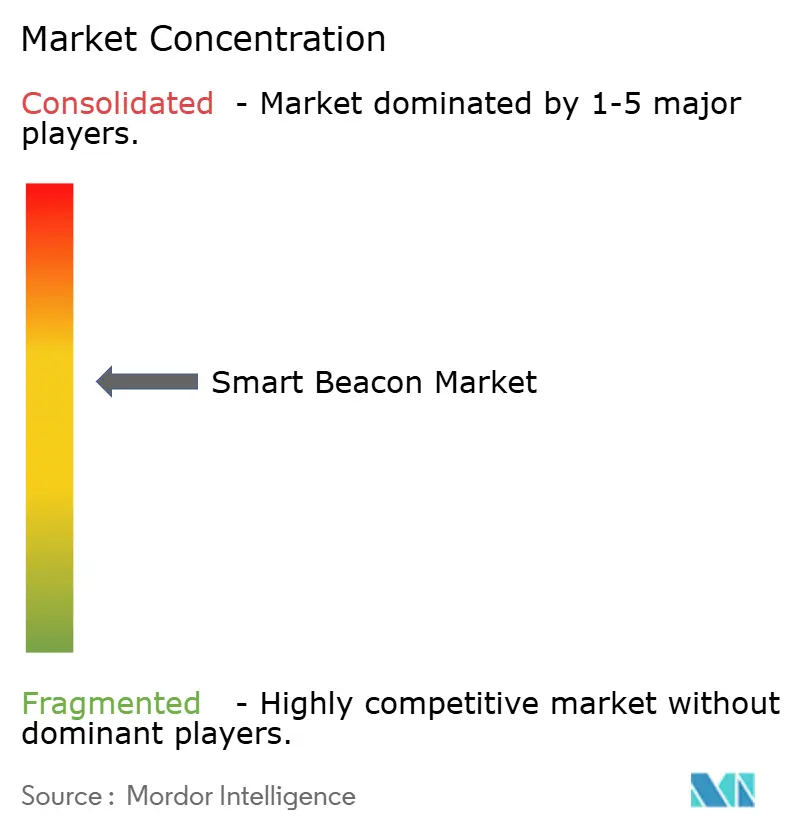


Recent Industry Developments
- April 2025: Zebra Technologies announced Q1 2025 net sales of USD 1.308 billion, up 11.3% year-over-year.
- March 2025: Apple released iOS 18.2 with enhanced Bluetooth permission flows and private Wi-Fi-address rotation.
- February 2025: Cisco reported Q2 FY 2025 revenue of USD 14.0 billion, with AI infrastructure orders exceeding USD 350 million.
- January 2025: Zebra Technologies completed the acquisition of Photoneo for USD 62 million, adding 3D vision to its asset-tracking portfolio.
Global Smart Beacon Market Report Scope
Beacons are small, wireless transmitters that use low-energy Bluetooth technology to send signals to other nearby smart devices. With its offerings as a service, hardware and software, the market focuses on various end-user applications, such as retail, sports, transportation, and logistics.
The Smart Beacon Market is segmented by Standard Type (iBeacon, Eddystone), by Connectivity (Bluetooth Low Energy, Wi-Fi), by End -Users (Retail, Sports, Transportation and Logistics, Construction, Aviation, Healthcare, and Automotive), and by Geography (North America (United States, Canada), Europe (Germany, United Kingdom, France, Rest of Europe), Asia Pacific (China, Japan, Australia, South Korea, Rest of Asia Pacific), Rest of the World).
The market sizes and forecasts are provided in terms of value in USD for all the above segments.
| iBeacon |
| Eddystone |
| AltBeacon |
| Bluetooth Low Energy (BLE) |
| Wi-Fi (802.11mc/FTM) |
| Ultra-Wideband Assisted |
| Proximity Marketing and Couponing |
| Indoor Navigation and Way-finding |
| Asset and Personnel Tracking |
| Occupancy and Environment Monitoring |
| Retail and Malls |
| Transportation and Logistics |
| Aviation and Airports |
| Healthcare Facilities |
| Sports and Entertainment Venues |
| Automotive OEMs |
| Smart Construction Sites |
| North America | United States | |
| Canada | ||
| Mexico | ||
| Europe | Germany | |
| United Kingdom | ||
| France | ||
| Rest of Europe | ||
| Asia-Pacific | China | |
| Japan | ||
| South Korea | ||
| Australia | ||
| Rest of Asia-Pacific | ||
| South America | Brazil | |
| Argentina | ||
| Rest of South America | ||
| Middle East and Africa | Middle East | Saudi Arabia |
| United Arab Emirates | ||
| Rest of Middle East | ||
| Africa | South Africa | |
| Kenya | ||
| Nigeria | ||
| Rest of Africa | ||
| By Standard Type | iBeacon | ||
| Eddystone | |||
| AltBeacon | |||
| By Connectivity | Bluetooth Low Energy (BLE) | ||
| Wi-Fi (802.11mc/FTM) | |||
| Ultra-Wideband Assisted | |||
| By Application | Proximity Marketing and Couponing | ||
| Indoor Navigation and Way-finding | |||
| Asset and Personnel Tracking | |||
| Occupancy and Environment Monitoring | |||
| By End-User Industry | Retail and Malls | ||
| Transportation and Logistics | |||
| Aviation and Airports | |||
| Healthcare Facilities | |||
| Sports and Entertainment Venues | |||
| Automotive OEMs | |||
| Smart Construction Sites | |||
| By Geography | North America | United States | |
| Canada | |||
| Mexico | |||
| Europe | Germany | ||
| United Kingdom | |||
| France | |||
| Rest of Europe | |||
| Asia-Pacific | China | ||
| Japan | |||
| South Korea | |||
| Australia | |||
| Rest of Asia-Pacific | |||
| South America | Brazil | ||
| Argentina | |||
| Rest of South America | |||
| Middle East and Africa | Middle East | Saudi Arabia | |
| United Arab Emirates | |||
| Rest of Middle East | |||
| Africa | South Africa | ||
| Kenya | |||
| Nigeria | |||
| Rest of Africa | |||


Key Questions Answered in the Report
What is the current size of the smart beacon market?
Revenue is projected to rise at a 21.32% CAGR, reaching USD 11.04 billion by 2030.
Which region is growing the fastest in smart beacon adoption?
Asia-Pacific is forecast to expand at a 24.8% CAGR, outpacing other regions.
Which application is driving the next wave of smart beacon deployments?
Asset and Personnel Tracking is accelerating at a 27.3% CAGR as enterprises prioritize operational efficiency.
Why are energy-harvesting beacons important?
They eliminate battery maintenance, lowering lifetime total cost of ownership and enabling large-scale deployments.
What connectivity options are challenging Bluetooth’s dominance?
Wi-Fi 802.11mc fine-time-measurement is growing at a 29.5% CAGR due to its sub-meter accuracy over existing Wi-Fi infrastructure.
Page last updated on:
